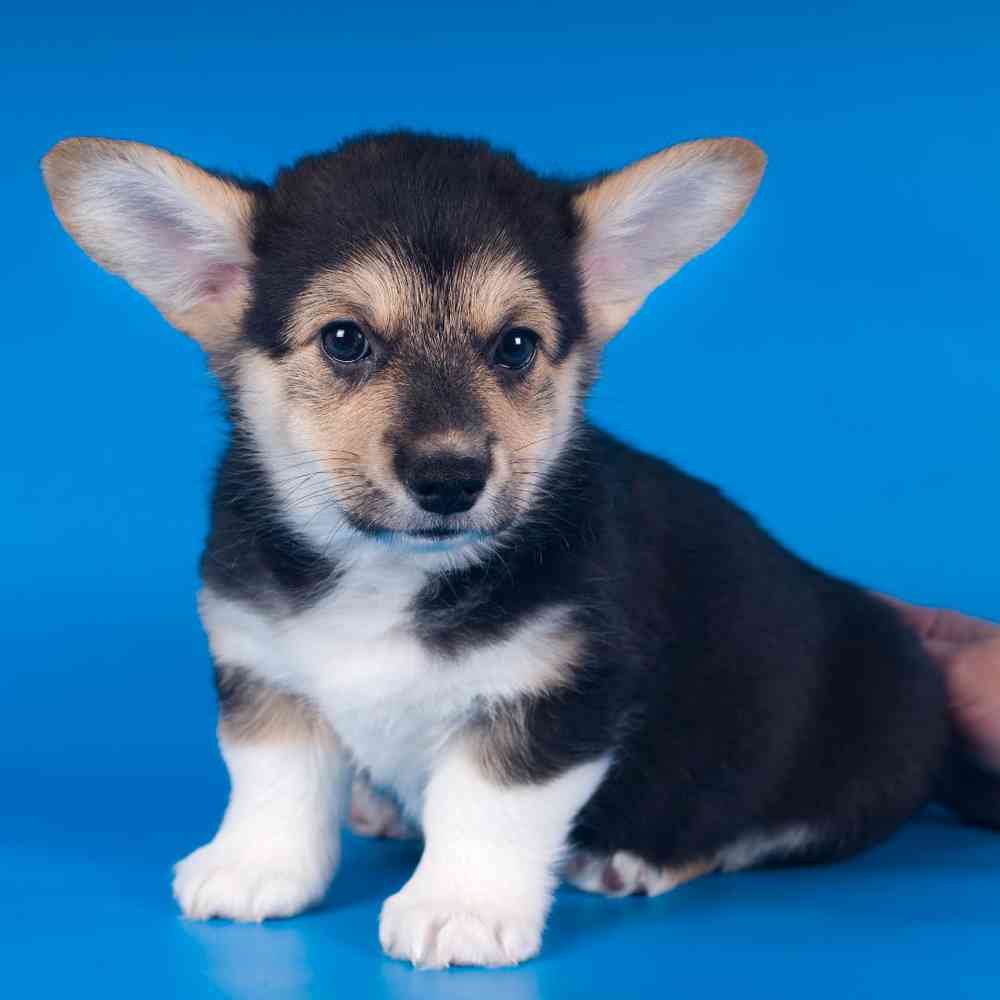
Apartment Friendly
AKC Registrable
Family Dog
Pembroke Welsh Corgi
Among the most agreeable of all small housedogs, the Pembroke Welsh Corgi is a strong, athletic, and lively little herder who is affectionate and companionable without being needy. They are one the world's most popular herding breeds.
Puppy Knowledge
Breed Info
Clubs, Registries & Associations
American Canine Association Continental Kennel Club Universal Kennel Club International American Kennel Club United All Breed Registry America's Pet Registry, Inc. United Kennel Club (Based on breed recognition. See store for details on this particular puppy.)
Group
Herding
Heritage
There are two Corgi breeds: the Cardigan Welsh Corgi and the Pembroke Welsh Corgi. The Pembroke Welsh Corgi was bred from the Cardigan Welsh Corgi, both dating back to sometime in the 10th century. One of the oldest herding breeds, the Corgi is known for their skilled herding of sheep, geese, horse, cattle and ducks. Today they are outstanding in agility, flyball, tracking and sheepdog trials.
Description
Small, up to 10-12” at the shoulders, weighing anywhere from 24-28 pounds. The Pembroke Welsh Corgi is short-legged dog in a sturdy body with a short weather-resistant double coat in colors of red, fawn, sable, or black and tan.
Health Awareness
The Pembroke Welsh Corgi has a life expectancy of 12-15 years and is prone to back disorders and spinal cord diseases, glaucoma, and epilepsy
Exercise/Energy Level
The Pembroke Welsh Corgi is a highly active breed, and requires a daily walk and off-leash play and running in a safe, fenced area. They also need mental stimulation to prevent boredom and destruction, so be sure to provide your Pembroke Welsh Corgi with plenty of interactive toys that challenge their problem-solving skills.
Additional Information
Grooming Requirements: Requires regular brushing and bathe only when necessary Coat: Medium Shedding: Average shedding Hypoallergenic: No, due to shedding Apartment Living: Good for apartment living if given sufficient exercise Lap Dog: Yes Good With Children: Good with all children when socialized while a puppy; remember that this is a herding breed and will nip at heels and hands in order to control so you must supervise your Pembroke Welsh Corgi to keep everyone safe Good With Other Pets: Good with other dogs when socialized while a puppy; not trustworthy with non-canine pets
Breed Standard
General Appearance
Low-set, strong, sturdily built and active, giving an impression of substance and stamina in a small space. Should not be so low and heavy-boned as to appear coarse or overdone, nor so light-boned as to appear racy. Outlook bold, but kindly. Expression intelligent and interested. Never shy nor vicious. Correct type, including general balance and outline, attractiveness of headpiece, intelligent outlook and correct temperament is of primary importance. Movement is especially important, particularly as viewed from the side. A dog with smooth and free gait has to be reasonably sound and must be highly regarded. A minor fault must never take precedence over the above desired qualities. A dog must be very seriously penalized for the following faults, regardless of whatever desirable qualities the dog may present: oversized or undersized; button, rose or drop ears; overshot or undershot bite; fluffies, whitelies, mismarks or bluies.
Size, Proportion, Substance
Height (from ground to highest point on withers) should be 10 to 12 inches. Weight is in proportion to size, not exceeding 30 pounds for dogs and 28 pounds for bitches. In show condition, the preferred medium- sized dog of correct bone and substance will weigh approximately 27 pounds, with bitches approximately 25 pounds. Obvious oversized specimens and diminutive toylike individuals must be very severely penalized. Proportions--Moderately long and low. The distance from the withers to the base of the tail should be approximately 40 percent greater than the distance from the withers to the ground. Substance--Should not be so low and heavy-boned as to appear coarse or overdone, nor so light-boned as to appear racy.
Head
The head should be foxy in shape and appearance. Expression--Intelligent and interested, but not sly. Skull--should be fairly wide and flat between the ears. Moderate amount of stop. Very slight rounding of cheek, not filled in below the eyes, as foreface should be nicely chiseled to give a somewhat tapered muzzle. Distance from occiput to center of stop to be greater than the distance from stop to nose tip, the proportion being five parts of total distance for the skull and three parts for the foreface. Muzzle should be neither dish-faced nor Roman-nosed. Eyes-Oval, medium in size, not round, nor protruding, nor deepset and piglike. Set somewhat obliquely. Variations of brown in harmony with coat color. Eye rims dark, preferably black. While dark eyes enhance the expression, true black eyes are most undesirable, as are yellow or bluish eyes. Ears-Erect, firm, and of medium size, tapering slightly to a rounded point. Ears are mobile, and react sensitively to sounds. A line drawn from the nose tip through the eyes to the ear tips, and across, should form an approximate equilateral triangle. Bat ears, small catlike ears, overly large weak ears, hooded ears, ears carried too high or too low, are undesirable. Button, rose or drop ears are very serious faults. Nose--Black and fully pigmented. Mouth--Scissors bite, the inner side of the upper incisors touching the outer side of the lower incisors. Level bite is acceptable. Overshot or undershot bite is a very serious fault. Lips--Black, tight with little or no fullness.
Neck, Topline, Body
Neck--Fairly long. Of sufficient length to provide over-all balance of the dog. Slightly arched, clean and blending well into the shoulders. A very short neck giving a stuffy appearance and a long, thin or ewe neck are faulty. Topline--Firm and level, neither riding up to nor falling away at the croup. A slight depression behind the shoulders caused by heavier neck coat meeting the shorter body coat is permissible. Body--Rib cage should be well sprung, slightly egg-shaped and moderately long. Deep chest, well let down between the forelegs. Exaggerated lowness interferes with the desired freedom of movement and should be penalized. Viewed from above, the body should taper slightly to end of loin. Loin short. Round or flat rib cage, lack of brisket, extreme length or cobbiness, are undesirable. Tail--Docked as short as possible without being indented. Occasionally a puppy is born with a natural dock, which if sufficiently short, is acceptable. A tail up to two inches in length is allowed, but if carried high tends to spoil the contour of the topline.
Forequarters
Legs--Short, forearms turned slightly inward, with the distance between wrists less than between the shoulder joints, so that the front does not appear absolutely straight. Ample bone carried right down into the feet. Pasterns firm and nearly straight when viewed from the side. Weak pasterns and knuckling over are serious faults. Shoulder blades long and well laid back along the rib cage. Upper arms nearly equal in length to shoulder blades. Elbows parallel to the body, not prominent, and well set back to allow a line perpendicular to the ground to be drawn from tip of the shoulder blade through to elbow. Feet--Oval, with the two center toes slightly in advance of the two outer ones. Turning neither in nor out. Pads strong and feet arched. Nails short. Dewclaws on both forelegs and hindlegs usually removed. Too round, long and narrow, or splayed feet are faulty.
Hindquarters
Ample bone, strong and flexible, moderately angulated at stifle and hock. Exaggerated angulation is as faulty as too little. Thighs should be well muscled. Hocks short, parallel, and when viewed from the side are perpendicular to the ground. Barrel hocks or cowhocks are most objectionable. Slipped or double-jointed hocks are very faulty. Feet--as in front.
Coat
Medium length; short, thick, weather- resistant undercoat with a coarser, longer outer coat. Over-all length varies, with slightly thicker and longer ruff around the neck, chest and on the shoulders. The body coat lies flat. Hair is slightly longer on back of forelegs and underparts and somewhat fuller and longer on rear of hindquarters. The coat is preferably straight, but some waviness is permitted. This breed has a shedding coat, and seasonal lack of undercoat should not be too severely penalized, providing the hair is glossy, healthy and well groomed. A wiry, tightly marcelled coat is very faulty, as is an overly short, smooth and thin coat. Very Serious Fault--Fluffies--a coat of extreme length with exaggerated feathering on ears, chest, legs and feet, underparts and hindquarters. Trimming such a coat does not make it any more acceptable. The Corgi should be shown in its natural condition, with no trimming permitted except to tidy the feet, and, if desired, remove the whiskers.
Color
The outer coat is to be of self colors in red, sable, fawn, black and tan with or without white markings. White is acceptable on legs, chest, neck (either in part or as a collar), muzzle, underparts and as a narrow blaze on head. Very Serious Faults: Whitelies--Body color white, with red or dark markings. Bluies--Colored portions of the coat have a distinct bluish or smoky cast. This coloring is associated with extremely light or blue eyes, liver or gray eye rims, nose and lip pigment. Mismarks--Self colors with any area of white on the back between withers and tail, on sides between elbows and back of hindquarters, or on ears. Black with white markings and no tan present.
Temperament
Affectionate, Smart, Alert
Overview
About
At 10 to 12 inches at the shoulder and 27 to 30 pounds, a well-built male Pembroke presents a big dog in a small package. Short but powerful legs, muscular thighs, and a deep chest equip him for a hard day’s work. Built long and low, Pembrokes are surprisingly quick and agile. They can be red, sable, fawn, and black and tan, with or without white markings. The Pembroke is a bright, sensitive dog who enjoys play with his human family and responds well to training. As herders bred to move cattle, they are fearless and independent. They are vigilant watchdogs, with acute senses and a “big dog” bark. Families who can meet their bold but kindly Pembroke’s need for activity and togetherness will never have a more loyal, loving pet.
History
In medieval times, the kings of Europe advertised their majesty to their subjects and visiting emissaries by the richness of their possessions. Carpets, textiles, and tapestries were important factors in these displays of conspicuous consumption. The era’s best weavers were centered in Flanders, now northern Belgium. It was common for monarchs to stage talent raids to induce Flemish weavers to relocate to their kingdoms. So it was that in the year 1107, Henry I of Britain invited a community of these master craftsmen to live and work in the southwestern Wales. The weavers accepted Henry’s invitation and brought all they needed to re-create their agrarian way of life in their new homeland. This included the dogs they bred to herd cattle and sheep. These sturdy, short-legged herders were the foundation for the breed we now know as the Pembroke Welsh Corgi. The Pembroke has been a distinctly separate breed from his cousin the Cardigan Welsh Corgi since the late 1800s, but the two breeds often intermingled in the old Welsh breeding centers of Pembrokeshire and Cardiganshire. Today, the most noticeable differences between the breeds are the ears (the Pembroke’s are pointed and erect, the Cardi’s rounded) and the tail (the Cardi tale is much longer than the Pembroke’s). The world’s most famous Pembroke fan is Elizabeth II. The queen got her first Pembroke, Dookie, in 1933 and has not been without one or more since.
Standard
Low-set, strong, sturdily built and active, giving an impression of substance and stamina in a small space. Should not be so low and heavy-boned as to appear coarse or overdone, nor so light-boned as to appear racy. Outlook bold, but kindly. Expression intelligent and interested. Never shy nor vicious.
Nutrition
The Pembroke Welsh Corgi should do well on a high-quality dog food, whether commercially manufactured or home-prepared with your veterinarian’s supervision and approval. Any diet should be appropriate to the dog’s age (puppy, adult, or senior). Some dogs are prone to getting overweight, so watch your dog’s calorie consumption and weight level. Treats can be an important aid in training, but giving too many can cause obesity. Learn about which human foods are safe for dogs, and which are not. Check with your vet if you have any concerns about your dog’s weight or diet. Clean, fresh water should be available at all times.
Grooming
The Pembroke has a thick, weatherproof double coat—a soft, light undercoat covered by a coarse outer coat. The breed sheds a fair amount on a daily basis, and even more so in the late spring/early summer. A daily once-over with a comb and a slicker brush will remove a lot of the shed hair before it is all over the house. During shedding season, baths help to loosen the dead hairs—the dog must be completely dry before brushing begins—and a rake helps strip out the undercoat. As with all breeds, the Corgi’s nails should be trimmed regularly, and ears checked to be sure they are clean and healthy.
Exercise
A strong, athletic little dog developed to herd cattle and other livestock, the Pembroke Welsh Corgi loves physical activity and is happiest when he has a job to do. Corgis benefit from moderate daily exercise to maintain their physical and mental health. Pembrokes can do well on long walks or slow jogs, but their short legs won’t allow them to keep up with a bicycle rider. Avoid extreme heat or cold, and always provide plenty of cool, fresh water after exercise. Many Pembrokes enjoy and excel at canine activities such as agility, herding, obedience, and tracking events.
Training
As with all breeds, early socialization and puppy training classes are strongly recommended. Gently exposing the puppy to a wide variety of people, places, and situations between the ages of 7 weeks and 4 months will help him develop into a well-adjusted, well-mannered adult. Pembrokes often have a mind of their own, but they are energetic, willing, and highly intelligent partners who respond well to training. Positive, reward-based training works best with this sensitive breed.
Health
The Pembroke is typically a healthy breed, and responsible breeders screen their stock for health conditions such as elbow and hip dysplasia, eye disorders, cardiac issues, degenerative myelopathy, and von Willebrand’s disease, a bleeding disorder. As with all breeds, a Pembroke’s ears should be checked weekly for signs of infection, and the teeth should be brushed regularly.

















